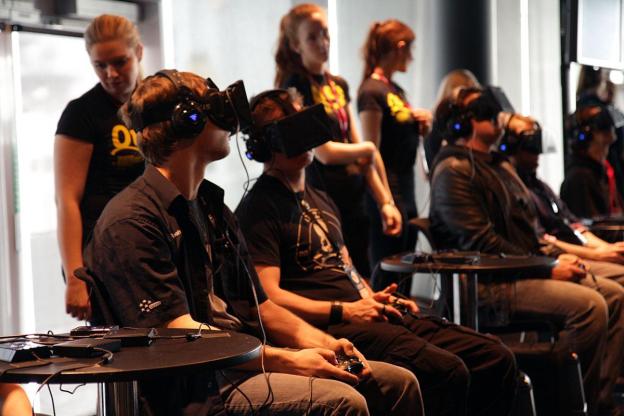
The Oculus Rift-powered EVR is like a secret project developed by a team of super heroes. By day, the small, mild mannered team that assembled the multiplayer space-dogfighting game works in a variety of roles in the EVE Online and Dust 514 realms, but by night these superdevs assembled one of the most impressive showcases yet for Palmer Luckey’s VR headset.
Sigurdur ‘Siggy’ Gunnarsson is one of those superdevs, a senior web developer by day whose current focus is on Dust. The development of EVR was a passion project for he and his fellow Oculus true believers at CCP. They all recognize that there are some inherent technical and creative challenges here, both in terms of polishing off the game and integrating it into the larger EVE universe. They also recognize that it’s early days for the tech, and that building excitement with examples such as EVR is crucial in driving wider interest.

“I wanted to pull people [at CCP Games] together to do something with me,” he continues. “Slowly, over the summer and the following fall, I started checking with people. Then I met [fellow EVR dev] Robert Clarke. We both were day one backers of the Kickstarter and we started talking.”
Word spread quickly and it wasn’t long before Gunnarsson and Clarke were joined by others. A core team of four people took on the bulk of the work, with around 10 others contributing in various ways, at various times. The first challenge was figuring out what the heck to do. In retrospect, it seems obvious: EVE Online is a game of ship-to-ship space combat, so wouldn’t it be cool to hop directly into the cockpit of one of the game’s fighter craft?

“So it snowballed,” Gunnarsson says, grinning. “Last year was more ideas because we didn’t have a dev kit and hadn’t seen [Oculus Rift] ourselves. We weren’t convinced how good it would actually be. Early this year we were playing around with tools in Unity when we got in touch with the Oculus guys and got a very early alpha version of the kit. From that point onward we started actual development.”
Work went quickly from there. Very quickly. The game was built almost completely from scratch over the course of seven weeks, with much of the work being put in during off-hours and weekends. The excitement was palpable. No one saw the project as work. They were building something that excited them on a personal level. Gunnarsson rattles off a rapid-fire list of titles that inspired the team’s efforts.

“We started inputting in assets from EVE, did some network coding, got the multiplayer running really early on,” Gunnarsson says. “In one week we had something running, and from that point onward the game changed every day, every two days. We had a few internal CCP demos where we just invited everyone to the dining hall to come play the game, and people were really liking it. For me, Unity was the key thing that allowed us to do that. We just met after work and we had loads of ideas, and then the prototype was working later that night. So it just went really, really fast.”
Unity is a flexible game engine, and a surprisingly powerful one given how scalable it is, but creating something for Oculus VR to play introduces some unique challenges on the interface side. It’s not that the programming is hard; it’s the creating. You’ve got a situation where these tech-minded developers are solving for problems that no one else has tried to tackle before.

The list goes on from here. “Leveraging the stereoscopic view to give you the sense that you’re there; getting the scale of the cockpit right, getting the sense of the glass over you… all of these things are things you don’t need to deal with when you’re doing a flat 2D game.” Gunnarsson is quick to admit that EVR is very much a “work-in-progress.”
There is, of course, the obvious question of how EVR might be fitted with netcode to work with online play. It is a multiplayer game after all, but the FanFest demo was built around local play only. According to Gunnarsson, the game is technically ready for online play as it stands right now, though it still needs some work before it can be functional outside of a dev setting.
“We are doing some shortcuts and some cheating [for FanFest],” he explains. “Hacking this thing would be really easy. I’m not embarrassed to say this because we were just in a hurry. So we would need to fix some of those issues and make sure that if you have hiccups in your network code or a slower connection, it would still work. We haven’t done a lot of testing on that. So there would be some mopping up and some tweaking that we would need to do there.”
“Also, with our server, you need to know how to start it up and all of that. So we would have to package it in an easier to use format. But it’s not that much work. I’m really hoping that we’ll be able to release this in some form to the public, but we don’t know yet. We haven’t decided.”

There may be no decisions, but you hear Gunnarsson say all of that and it becomes clear enough that serious thought has been put into sussing out the technical challenges. The creative challenges are a bit trickier. EVE Online may be built primarily around ship-to-ship interactions, but the fiction of cloned capsuleers doesn’t really mesh with the idea of physically sitting behind a starfighter’s cockpit controls.
There’s also the bigger picture issue of Oculus not technically being a consumer product at this point. Anyone can place a pre-order on the official website and get their own kit for $300, but this is still a development kit. It’s designed for tech-minded people, and specifically those who intend to create something for what amounts to a brand new platform.

“I know they’ve been playing around with new hardware,” he adds. “There are some really hard technical problems that need to be solved for this to make it really approachable, so no one gets motion sickness or anything like that. The refresh rate needs to be really, really high. The rendering power needed to render a world and get good graphics at that speed is pretty insane.”
It’s a daunting set of problems, but it’s one that Oculus continues to work at even as homegrown teams like the one at CCP labor over passion projects like EVR. There’s a real sense of excitement in the development community over what the VR headset represents. You got it from John Carmack in 2012. From Gunnarsson at FanFest. From any number of others who have had things to say about the ambitious tech.
There’s an unstated, completely informal effort at this point to take up the grassroots banner and preach the word of Oculus Rift to the masses. The more people that get interested, the more likely the unique interface will see wide adoption. “That’s why we’re doing this,” Gunnarsson says matter-of-factly. “We want this done. We want this to become a reality for ourselves, as gamers.”


